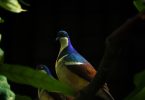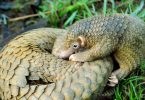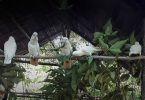The Philippine Duck (Anas luzonica), also known as the Luzon Duck or Papan in Tagalog, is a species of dabbling duck that is native to the Philippines. It belongs to the family Anatidae and is recognized for its distinctive features and its importance in the country’s avian biodiversity.
The Philippine Duck is a medium-sized duck with a body length of about 51 to 58 centimeters. Male and female Philippine Ducks have different plumage. The male typically has a darker head and neck, with a brownish body. The female’s plumage is generally lighter and has more mottling. Both sexes of the Philippine Duck have a characteristic blue patch on their wings, which becomes prominent during flight. They have a distinct white eye-ring and a yellowish bill. It is known for its quiet and subtle vocalizations.
This species is endemic to the Philippines, meaning it is found nowhere else in the world. Philippine Ducks are typically found in freshwater habitats such as marshes, swamps, lakes, rivers, and agricultural fields. They prefer areas with abundant aquatic vegetation for nesting and foraging.
It is a dabbling duck, which means it feeds primarily on the water’s surface or by tipping its body to reach underwater vegetation. Its diet includes a variety of aquatic plants, seeds, insects, crustaceans, and small fish. These ducks are known to form small groups during the non-breeding season, but they can become solitary or form pairs during the breeding season.
The Philippine Duck is classified as “Vulnerable” on the International Union for Conservation of Nature (IUCN) Red List of Threatened Species. Habitat loss due to wetland conversion for agriculture and urbanization is one of the main threats to the Philippine Duck’s population. Hunting and disturbance during the breeding season also contribute to their declining numbers.
Conservation efforts for the Philippine Duck include the protection of key wetland habitats and raising awareness about the importance of conserving these birds. They are protected under Philippine law, and hunting is regulated.
Where to see the Philippine Duck?
There are several wildlife sanctuaries and protected areas in the Philippines where you may have the opportunity to see the Philippine Duck (Anas luzonica) in its natural habitat. Keep in mind that bird sightings can vary based on seasons and other factors, so it’s a good idea to contact local authorities or experts before planning your visit. Here are a few wildlife sanctuaries where you might spot the Philippine Duck:
Olango Island Wildlife Sanctuary (OIWS), Cebu: Olango Island is a critical stopover for migratory birds, including the Philippine Duck. The sanctuary, located in Lapu-Lapu City, Cebu, is an important habitat for various bird species, especially during migration periods.
Naujan Lake National Park, Oriental Mindoro: This national park is known for its diverse wetland ecosystem, making it a potential habitat for the Philippine Duck. The Naujan Lake is a Ramsar site and home to various bird species, including waterfowl.
Balanga Wetland and Nature Park, Bataan: This park is known for its wetland habitats and serves as a haven for various bird species. While not guaranteed, you might spot the Philippine Duck here, especially during certain seasons.
Remember that the Philippine Duck is a native species and its presence can vary based on local conditions and factors.
The Philippine Duck is an important symbol of the country’s biodiversity and serves as a reminder of the need to protect and conserve the unique species found within its borders.
Photo Gallery

Additional Information
Read more about the wildlife in the Philippines. Check out the links below to discover more!







